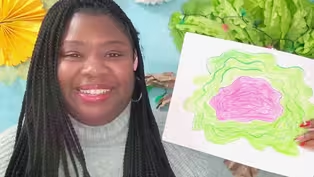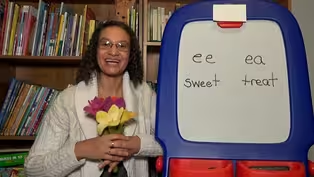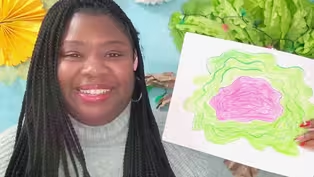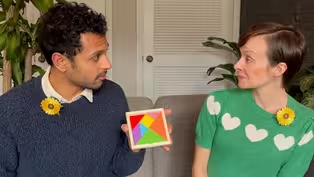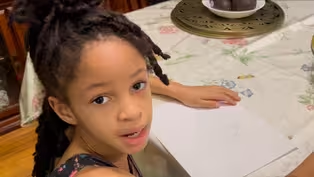
A RED CABBAGE TEST
Clip: 5/19/2023 | 7m 59sVideo has Audio Description, Closed Captions
Cassondra Easterling and her children use cabbage water to test the acidity of fruit juice
What color will red cabbage water turn when mixed with fruit juice? Cassondra Easterling and her children conduct an experiment to explore if a lemon, apple, and tomato are more acidic or basic.
See all videos with Audio DescriptionADProblems playing video? | Closed Captioning Feedback
Problems playing video? | Closed Captioning Feedback
Let's Learn is a local public television program presented by THIRTEEN PBS

A RED CABBAGE TEST
Clip: 5/19/2023 | 7m 59sVideo has Audio Description, Closed Captions
What color will red cabbage water turn when mixed with fruit juice? Cassondra Easterling and her children conduct an experiment to explore if a lemon, apple, and tomato are more acidic or basic.
See all videos with Audio DescriptionADProblems playing video? | Closed Captioning Feedback
How to Watch Let's Learn
Let's Learn is available to stream on pbs.org and the free PBS App, available on iPhone, Apple TV, Android TV, Android smartphones, Amazon Fire TV, Amazon Fire Tablet, Roku, Samsung Smart TV, and Vizio.
Providing Support for PBS.org
Learn Moreabout PBS online sponsorship[upbeat music] - Hi friends, my name is Cassondra and these are my helpers, - Noel - and Emery.
- And we're here today to do a fun science experiment with you.
Today, we are going to be doing some science in the kitchen and we are going to be using some fruits and vegetables that maybe you have at home and maybe you eat them sometimes.
So today we are going to be starting with some really pretty liquid here.
This liquid looks purple and we made that liquid using a purple cabbage.
Now this is a green cabbage.
This is the cabbage that maybe you see more often at the store, but there are also purple ones.
Now we used purple cabbage and we boiled it and it made this water nice and purple.
And we're going to use that water that is now purple from when we boiled the cabbage to do our experiment today.
We are going to be mixing this water with some juice from some fruits and vegetables that maybe you eat sometimes.
So the first thing we're going to be looking at is this.
Now friends at home, what is this?
Noel and Emery, what do we have here?
- A lemon.
- A lemon.
- A lemon.
Now have you had a lemon before?
- Yes.
- Yes.
- Yes, what does a lemon taste like?
- It's like sour.
- That's right, a lemon tastes sour.
It tastes sour because a lemon is acidic.
Can you say that, say acidic.
- Acidic.
- Acidic.
- Good, a lemon is acidic.
Now today in the experiment that we're going to be doing when we pour a liquid into our purple cabbage juice that is more acidic, it is going to turn the purple red.
Or it might just stay more purple.
That will mean that our liquid is acidic.
Now on the other hand, something like celery.
Have you had celery before?
- Yes.
- Yes.
- What about you friends at home?
Have you had celery before?
I really like celery.
But is it sour?
- No.
- No.
- No, celery is not sour.
Celery is going to be more basic.
And when our fruits and vegetables are more basic, they are going to turn our purple cabbage water over here blue, green, or yellow.
So we are going to be pouring these juices that we made using our blender into the purple cabbage water.
And we're gonna see what happens.
Do you wanna give this a try?
- Yeah.
- Yeah.
- All right, so we're gonna make some predictions.
All right, so let's think about the purple cabbage water here.
And let's think about the lemon juice.
Okay, we said that the lemon juice is going to be more: - Acidic.
- Acidic.
- Acidic, good.
So what color do we think our water is going to turn when we pour the lemon juice in there?
What color do you think?
- I think red.
We think it's probably gonna, probably gonna be either red or a purple color because that means it is acidic.
So I am going to put this A for acidic over here because that's our prediction.
We think that the water will turn red or maybe stay a color of purple.
So let's see if we are right.
I'm going to leave this here so that we can just see what it starts out like.
And then let's, woo.
Let's get another one and pour the lemon juice in there.
Oh, let's see what happens.
Emery, do you think you could help us out with that?
- Yeah.
- Okay, come over here, Emery.
Can you get that lemon juice?
Okay, let's lift you up a little bit.
And can you pour it into the first cup?
Yeah, pour it in, let's see what happens.
Oh, whoa.
Okay, thank you, Emery, wow.
Friends at home, look at that.
Can you see the difference?
So were we right, did it turn a red or purple color?
- Yes.
- Wow, we were right about that one.
So our lemon, and let's put that here.
Our lemon turns the water red or red colored.
Let's put that over there on the acidic side.
Let's try another one.
Which one do you wanna try next?
- Tomato!
- The tomato.
Okay, friends at home.
Here we go, we have a tomato.
We made some tomato juice with our blender.
So let's give it a try and see what happens.
So Emery, can you pour the tomato juice into the first cup for us?
And let's see what happens.
All right, take a look at that one, friends at home, that one definitely changed colors.
Look at what it started at.
But look, it didn't change as much as the lemon.
Look at that.
Not as much, but it did definitely change on the red side.
So what does that mean?
If it turned more red, does that mean that the tomato juice was more acidic or more basic?
What does that mean when it turns more red?
Look at our signs.
If it turns more red is it acidic or basic?
- It's acidic.
- It's acidic, yeah, that's right.
Okay, so let's put an A for acidic on our tomato juice.
All right, now let's try another one.
Let's try the apple?
You wanna try the apple?
Okay, let's try our apple.
Friends at home we have an apple.
We have some apple juice that we made.
Let's see what happens.
Noel, can you try this one for us?
Noel, what do you think?
Do you think it's gonna be more sour like the lemon and the tomato?
Or more basic and turn blue, green or yellow?
- I think it's gonna be basic.
- More basic?
All right, let's see if it is basic.
And turns blue, green or yellow.
So, Noel, can you give it a try?
- Yes.
- Go ahead.
Okay, it kinda did change.
- Yeah!
- Oh, look, it did change.
It is more blue.
Interesting.
That one's pretty.
Look at the difference.
Oh wow, look at that, that's so pretty.
Wow, we're getting a rainbow over here.
All right.
Now we have some more that we don't have time to try right now, but maybe you could try them at home.
Maybe you could try some pickle juice.
Maybe you could try some carrot juice and see if your purple cabbage water turns more red, or more blue, green or yellow.
Thanks for joining us today, friends.
- [All] Bye!
Video has Audio Description, Closed Captions
Clip: 6/12/2023 | 7m 31s | Darlene Thomas reads RAINING by Pingping Xu with illustrations by Graca Lima. (7m 31s)
Video has Audio Description, Closed Captions
Clip: 5/19/2023 | 7m 49s | Lia Zuilivia from Studio in a School draws the lines and shapes of a houseplant. (7m 49s)
LONG E SOUNDS SPELLED EE AND EA
Video has Audio Description, Closed Captions
Clip: 5/19/2023 | 8m | Anna Scretching-Cole explores long e vowel sounds spelled with ee and ea. (8m)
Video has Audio Description, Closed Captions
Clip: 5/19/2023 | 7m 31s | Darlene Thomas reads RAINING by Pingping Xu with illustrations by Graca Lima. (7m 31s)
Video has Audio Description, Closed Captions
Clip: 5/19/2023 | 11m 37s | Diane Sanlatte teaches a song about the four seasons in Spanish. (11m 37s)
USING TANGRAMS TO MAKE FLOWERS AND TREES
Video has Audio Description, Closed Captions
Clip: 5/19/2023 | 9m 57s | Omar Etman and Lily Fincher show how to use tangrams to make flowers and trees. (9m 57s)
ZURI SHOWS HOW TO DRAW A FLOWER!
Video has Audio Description, Closed Captions
Clip: 5/19/2023 | 59s | Zuri shows how to draw a flower. (59s)
Providing Support for PBS.org
Learn Moreabout PBS online sponsorshipSupport for PBS provided by:
Let's Learn is a local public television program presented by THIRTEEN PBS
